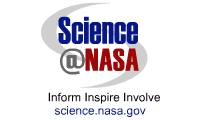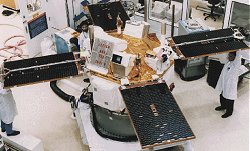 Space Science News home |
|
 Space Science News home |
|
 November 16,
1998: When the Leonid meteor shower
erupts tomorrow, sky-watchers on Earth have little to fear. Leonid
meteoriods, cast-off debris from comet Tempel-Tuttle, are smaller
than a grain of sand and much less dense. They are so insubstantial
that they disintegrate almost immediately when they hit Earth's
atmosphere. The result is a shooting star. November 16,
1998: When the Leonid meteor shower
erupts tomorrow, sky-watchers on Earth have little to fear. Leonid
meteoriods, cast-off debris from comet Tempel-Tuttle, are smaller
than a grain of sand and much less dense. They are so insubstantial
that they disintegrate almost immediately when they hit Earth's
atmosphere. The result is a shooting star. Right: The Advanced Composition Explorer (ACE), a sun-studying satellite shown here in the laboratory, is now in orbit between the Sun and Earth at the L-1 point (a point in space where the gravitational pulls of Earth and the sun are balanced). Since the center of the Leonid stream is closer to the L-1 orbit than to Earth, ACE will see an even more intense storm than Earth-orbiting satellites. Earth-orbiting satellites might have more to worry about. Tiny meteoroids can poke holes in solar panels, pit surfaces, and short out electronics. The hazard from the Leonids is greater than the danger from most meteor showers for two reasons. The debris stream from comet Tempel-Tuttle is particularly dense, and the Leonid meteoroids travel at very high velocities, nearly 45 miles per second compared to 12 miles per second for average meteoroids. Nevertheless, NASA and Department of Defense experts do not classify the risk to most satellites as serious. With proper precautions, such as pointing vulnerable systems away from the incoming meteoroids, most damage can be avoided. |
 Sign up for our EXPRESS SCIENCE NEWS delivery |
The spacecraft closest to the predicted position of the Leonids meteor stream is NASA's Advanced Composition Explorer (ACE), a sun-studying satellite managed from the Goddard Space Flight Center (GSFC). GSFC technicians plan to tilt ACE by 20 degrees and power down sensitive instruments to avoid electrical discharges if a meteoroid should hit. Goddard controllers will take similar steps to protect 22 other GSFC-managed spacecraft including SOHO and the Hubble Space Telescope. |
Short circuits are one of the greatest dangers to satellites.
Meteoroids that hit spacecraft can disintegrate, creating a cloud
of electrically charged plasma. Under the right conditions, this
plasma cloud can set off a chain reaction causing a massive short
circuit. The loss of the European Space Agency's Olympus communications
satellite in 1993 was attributed to a strike from a Perseid
meteoroid, and the resulting plasma discharge that zapped
the spacecraft's delicate electronics.  Like many other
spacecraft, he Hubble Space Telescope (HST) will point away from
the Leonids to avoid damage, but it won't stop observing. For
a 10-hour period around the peak of the storm the telescope will
be oriented with its aft bulkhead facing into the direction of
the meteoroid stream. Hubble's solar panels will lay flat, or
parallel to the meteoroid flow. Like many other
spacecraft, he Hubble Space Telescope (HST) will point away from
the Leonids to avoid damage, but it won't stop observing. For
a 10-hour period around the peak of the storm the telescope will
be oriented with its aft bulkhead facing into the direction of
the meteoroid stream. Hubble's solar panels will lay flat, or
parallel to the meteoroid flow. Hubble will be aimed at a quasar, the bright core of an active galaxy, approximately 10 billion light-years away. The object of study is not the quasar itself but the surrounding galaxies, protogalaxies and primordial hydrogen clouds between us and the quasar. |
 A 900 micron impact crater found on the HST WF/PC camera radiator in 1994. more info.. |
Hubble will also be used, indirectly, to study the meteor stream.
Each time a meteoroid hits, the telescope will wobble slightly.
Scientists plan to record the series of bumps and wiggles as
the HST stares at the quasar to learn about the distribution
of meteoroid masses and velocities. The HST has had an encounter with the Leonids once before. This image shows a 900 micron impact crater in the radiator of Hubble's Wide Field and Planetary Camera. It was discovered in 1994 after a Leonid meteor shower in 1993. The camera was not damaged by the impact. |

Watch Your Favorite Satellite Weather the StormExperts are predicting that the Leonid meteor storm will be
most intense at 1900 UT November 17th over eastern Asia. That's
the part of Earth that will face into the meteor stream as we
pass through the the orbital plane of comet Tempel-Tuttle. Thanks
to NASA Liftoff you
can monitor your favorite satellites during the storm using a
Java applet called JTrack.
|
| Web Links | |
|
Space Environments and Effects Program - download software from NASA's Marshall Space Flight Center to calculate the probability of impacts by Leonid meteors on spacecraft in Earth orbit GSFC Spacecraft prepare for the Leonids - Links to live webcasts of the Leonid meteor shower Leonid meteor won't deter Hubble - Space Telescope Science Institute press release Leonids Live! - Links to live webcasts of the Leonid meteor shower 1998 Leonids Data Bank -- a useful summary of Leonids information from NASA Ames. The November Leonids: Will they Roar? -- from JPL Eyewitness accounts of the 1966 storm -- an Ames Research Center Archive NASA's Office of Space Science - press releases and other news related to NASA and astrophysics |
Related Stories: Great Expectations: the 1998 Leonids Meteor Shower -- the basics of the Leonid meteors. Includes eyewitness accounts from the great 1966 storm and observing hints for 1998. Halley's comet returns in bits and pieces -- story posted Oct 20 on the Orionid meteor shower Giacobinids dazzle observers - October's meteor outburst over Japan Tune-up for the Leonids - story posted Oct 7, discusses the astronomy of the Giacobinids External Links: The Leonids -- from Gary Kronk Meteors and Comets web site Leonids: the Night of Raining Fire -- Sky &Telescope article The Leonids: King of the Meteor Showers -- Sky &Telescope article |
|
More  Headlines Headlines
return to Space Science News Home Author: Tony
Phillips |